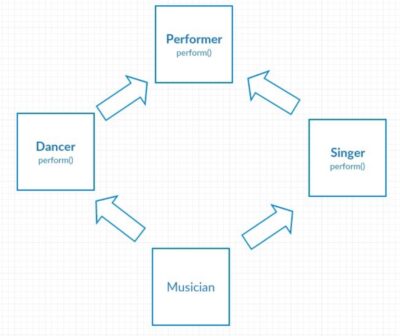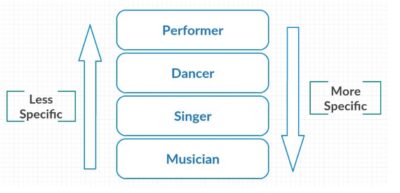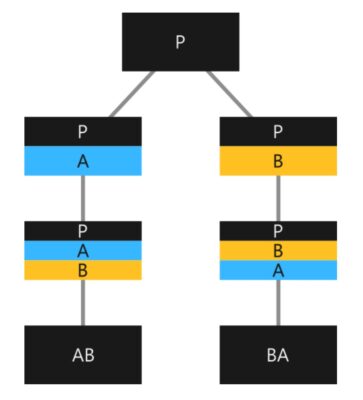关于 Dart mixin 的一些理解。理解 mixin 概念的关键在于理解中间类。
Mixins are a way of reusing code in multiple class hierarchies
先来看一个简单例子:
|
1 2 3 4 5 6 7 8 9 10 |
class Piloted { int astronauts = 1; void describeCrew() { print('Number of astronauts: $astronauts'); } } class PilotedCraft extends Spacecraft with Piloted { // ··· } |
PilotedCraft 拥有 astronauts 字段和 describeCrew() 方法。
mixin 是什么?
维基百科中这样定义 mixin:
In object-oriented programming languages, a Mixin is a class that contains methods for use by other classes without having to be the parent class of those other classes.
即,mixin 是另外一个普通类,我们可以在不继承这个类的情况下从这个类”借用”方法和变量。
Support for the mixin keyword was introduced in Dart 2.1. Code in earlier releases usually used abstract class instead.
从这个角度来讲,mixin 不过是 abstract class。
Java tries to make up for this by using Interfaces, but that is not as useful or flexible as mixins.
从这个角度来讲,可以认为 mixin 是带实现的接口。
小节
- mixin 有点类似
abstract class - mixin 有点类似
interface - 不能继承 mixin
- 可以使用
mixin,abstract class,class来作为 mixin
如何使用 mixin?
使用 mixin 的方法很简单:with 关键字后面跟上 mixin 的名字即可。
|
1 2 3 4 5 6 7 8 9 10 11 |
class Musician extends Performer with Musical { // ··· } class Maestro extends Person with Musical, Aggressive, Demented { Maestro(String maestroName) { name = maestroName; canConduct = true; } } |
实现 mixin 的方法同样也很简单:创建一个继承自 Object 的类并且不要声明构造方法。如果想让 mixin 作为普通类使用,使用 class 关键字;如果不想让 mixin 作为普通类使用,使用 mixin 关键字代替 class。
|
1 2 3 4 5 6 7 8 9 10 11 12 13 14 15 |
mixin Musical { bool canPlayPiano = false; bool canCompose = false; bool canConduct = false; void entertainMe() { if (canPlayPiano) { print('Playing piano'); } else if (canConduct) { print('Waving hands'); } else { print('Humming to self'); } } } |
on 的用法
The keyword on is used to restrict our mixin’s use to only classes which either extends or implements the class it is declared on. In order to use the on keyword, you must declare your mixin using the mixin keyword
|
1 2 3 4 5 6 7 |
class B {} mixin Y on B { void hi() { print('hi'); } } class Q with Y {} |
则有如下错误提示:
Error: 'Object' doesn't implement 'B' so it can't be used with 'Y'.
on 关键字限制了 Y 的使用范围:Y 只能用于继承或实现了 B 的类。修复方式是让 Q 继承自 B:
|
1 |
class Q extends B with Y {} |
mixin 解决了什么问题?
mixin 解决了多重继承中的 Deadly Diamond of Death(DDD) 问题。
多重继承问题简单描述。各个类的继承关系如下:
|
1 2 3 4 5 6 7 8 9 10 11 12 13 14 |
class Performer { abstract void perform(); } class Dancer extends Performer { void perform() {} } class Singer extends Performer { void perform() {} } class Musician extends Dancer, Singer { } |
问题来了,当调用 Musician.perform() 时,到底会调用哪个 perform() 方法是模糊的。
来看 mixin 如何解决这个问题。见 Dart for Flutter : Mixins in Dart - Flutter Community - Medium
|
1 2 3 4 5 6 7 8 9 10 11 12 13 14 |
class Performer { abstract void perform(); } mixin Dancer { void perform() {} } mixin Singer { void perform() {} } class Musician extends Performer with Dancer, Singer { } |
现在,当调用 Musician.perform() 时,到底会调用哪个 perform() 方法是确定的。在这里是调用 Singer.perform()。
mixin 有一套明确的机制来选择调用哪个方法。
假设 Musician 类使用多个 mixin (Dancer, Singer)。该类有个方法名为 perform(),Musician 类继承自 Performer 类。
- 首先,将
Performer类置于栈顶 - 其次,后声明的 mixin 优先于先声明的 mixin。按顺序将 mixin 置于栈中,在这里分别是
Dancer,Singer - 最后,将
Musician类自己置于栈中。Musician类中的perform()被优先调用
Dart 使用的是单重继承 (Java 也是单重继承,C++ 是多重继承)。多重继承更为强大,但会引起 Deadly Diamond of Death(DDD) 问题。
Java 使用接口(interface)来部分实现多重继承。多重继承的问题是需要在每个类中实现接口(interface),所以并不是一个好的方案。(实际上 Java 已经通过默认方法修复了这个问题)
所以 Dart 中就有了 mixin。
理解 mixin
Mixins in Dart work by creating a new class that layers the implementation of the mixin on top of a superclass to create a new class — it is not “on the side” but “on top” of the superclass, so there is no ambiguity in how to resolve lookups.
Mixins is not a way to get multiple inheritance in the classical sense. Mixins is a way to abstract and reuse a family of operations and state. It is similar to the reuse you get from extending a class, but it is compatible with single-inheritance because it is linear.
StackOverflow
|
1 2 3 4 5 6 7 8 9 10 11 12 13 14 15 16 17 18 19 20 21 22 23 24 25 26 27 |
class A { String getMessage() => 'A'; } class B { String getMessage() => 'B'; } class P { String getMessage() => 'P'; } class AB extends P with A, B {} class BA extends P with B, A {} void main() { String result = ''; AB ab = AB(); result += ab.getMessage(); BA ba = BA(); result += ba.getMessage(); print(result); } |
以上这段代码输出 BA。
从语义上讲以上这段代码等同于:
|
1 2 3 4 5 6 7 8 9 |
class PA = P with A; class PAB = PA with B; class AB extends PAB {} class PB = P with B; class PBA = PB with A; class BA extends PBA {} |
继承结构图是这样的:
Since each mixin application creates a new class, it also creates a new interface (because all Dart classes also define interfaces). As described, the new class extends the superclass and includes copies of the mixin class members, but it also implements the mixin class interface.
In most cases, there is no way to refer to that mixin-application class or its interface; the class for Super with Mixin is just an anonymous superclass of the class declared like class C extends Super with Mixin {}. If you name a mixin application like class CSuper = Super with Mixin {}, then you can refer to the mixin application class and its interface, and it will be a sub-type of both Super and Mixin.
理解 mixin 的关键在于它是线性的。
使用场景
- 在没有共同父类的各个类中共享代码时
- 在父类中实现某种方法无意义时
在 Dart 语言中,我们经常可以看到对 mixin 关键字的使用,根据字面理解,就是混合的意思。那么,mixin 如何使用,它的使用场景是什么呢。
从一个实例说起
我们假设一个需求,我们需要用多个对象表示一些 动物, 诸如 狗、鸟、鱼、青蛙。其中
- 狗会跑
- 鸟会飞
- 鱼会游泳
- 青蛙是两栖动物,会跑,并且会游泳
基于如下一些考虑
- 动物特性可能会继续增多,并且一个动物可能具备多种技能
- 动物种类很多,但是可以归大类。例如 鸟禽、哺乳类
我们使用如下设计
- 动物继承自 Animal 抽象类
- 跑、飞、游 抽象为接口
代码如下:
|
1 2 3 4 5 6 7 8 9 10 11 12 13 14 15 16 17 18 19 20 21 22 23 24 25 26 27 28 29 30 31 32 33 34 35 36 37 38 39 40 41 42 43 44 45 46 47 48 49 50 51 52 53 |
abstract class Animal { } class Run { run() { print('run'); } } class Fly { fly() { print('fly'); } } class Swim { swim(){ print('swim'); } } class Bird extends Animal implements Fly { @override fly() { super.fly(); } } class Dog extends Animal implements Run { @override run() { super.run(); } } class Fish extends Animal implements Swim { @override swim() { super.swim(); } } class Frog extends Animal implements Run,Swim { @override run() { super.run(); } @override swim() { super.swim(); } } |
这个时候,我们会发现编辑器报了个错
原来这个方法 Dart 会一直认为 super 调用是在调用一个 abstract 的函数,所以我们这时候需要把这里面集成的函数实现一一实现。
这时候问题来了,Frog 和 Fish 都实现了 Swim 接口,这时候 swim 函数的内容我们需要重复的写 2 遍!
回想一下我们当初在 Android 中写 Java 或者 Kotlin 的时候,其实也有类似问题,同一个 interface 内的 method, 我们可能需要重写 n 次,非常明显的代码冗余。
Java8 和 Kotlin 选择使用接口的 default 实现来解决这个问题:
|
1 2 3 4 5 |
interface IXX { default void xmethod() { /// do sth... } } |
而 Dart, 选择使用 mixin
修改上面的代码:
|
1 2 3 4 5 6 7 8 9 10 11 12 13 14 15 16 17 18 19 20 21 22 23 24 25 |
abstract class Animal { } mixin Run { run() { print('run'); } } mixin Fly { fly() { print('fly'); } } mixin Swim { swim(){ print('swim'); } } class Bird extends Animal with Flym {} class Dog extends Animal with Run {} class Fish extends Animal with Swim {} class Frog extends Animal with Run,Swim {} |
我们运行如下代码
|
1 2 3 4 5 6 |
Bird bird = Bird(); bird.fly(); Frog frog = Frog(); frog.run(); frog.swim(); |
输出如下:
|
1 2 3 |
fly run swim |
这里我们可以意识到,mixin 被混入到了具体的类中,实际也起到了实现具体特性的作用。但是相比实现接口来说,更加的便捷一点。
这里类的继承关系我们可以梳理成下图
当函数同名的时候
上述的例子结束了 mixin 的基本用法。我们可以看到每个类都可以通过 with 关键字,把 mixin 中定义的特性 “混入” 到自己这里来。但是这时候如果每个 mixin 的函数名是一样的,会发生什么呢?我们不妨重新写一个简单的例子。
|
1 2 3 4 5 6 7 8 9 10 11 12 13 14 |
class S { fun()=>print('A'); } mixin MA { fun()=>print('MA'); } mixin MB { fun()=>print('MB'); } class A extends S with MA,MB {} class B extends S with MB,MA {} |
运行如下代码
|
1 2 3 4 5 6 7 |
main() { A a = A(); a.fun(); B b = B(); b.fun(); } |
我们得到下面这个输出
|
1 2 |
MB MA |
这个时候我们会发现,最后混入的 mixin 的函数,被调用了。这说明最后一个混入的 mixins会覆盖前面一个 mixins 的特性。为了验证这个工作流程,我们稍微修改一下这个例子,给 mixins 的函数加上 super 调用。
|
1 2 3 4 5 6 7 8 9 10 11 12 13 |
mixin MA on S { fun() { super.fun(); print('MA'); } } mixin MB on S { fun() { super.fun(); print('MB'); } } |
继续执行上面的程序,输出结果如下
|
1 2 3 4 5 6 |
A MA MB A MB MA |
第一个 A#fun 为例子。我们发现实际的调用顺序为 MB -> MA -> A,这里我们可以看出来 mixin 的工作方式,是具有线性化的。
mixin的线性化
上面的示例,我们可以画一个图来表示 mixin是如何线性化的
Dart 中的 mixin 通过创建一个类来实现,该类将 mixin的实现层叠在一个超类之上以创建一个新类 ,它不是“在超类中”,而是在超类的“顶部”。
我们可以得到以下几个结论:
mixin可以实现类似多重继承的功能,但是实际上和多重继承又不一样。多重继承中相同的函数执行并不会存在 "父子" 关系mixin可以抽象和重用一系列特性mixin实际上实现了一条继承链
最终我们可以得出一个很重要的结论
声明 mixin 的顺序代表了继承链的继承顺序,声明在后面的 mixin,一般会最先执行
这里再提出一个假设,如果 MA 和 MB 都有一个函数叫 log, 如果在先声明的 mixin 中执行 log 函数,会发生声明事情呢?
代码如下:
|
1 2 3 4 5 6 7 8 9 10 11 12 13 14 15 16 17 18 19 20 21 22 23 24 25 26 |
mixin MA on S { fun() { super.fun(); log(); print('MA'); } log() { print('log MA'); } } mixin MB on S { fun() { super.fun(); print('MB'); } log() { print('log MB'); } } class A extends S with MA,MB {} A a = A(); a.fun(); |
这里按照习惯性的思维,我们可能会得到
|
1 2 3 4 |
A log MA MA MB |
的结果。实际上,我们的输出是
|
1 2 3 4 |
A log MB MA MB |
仔细思考一下,按照上面的工作原理,在 mixin 的继承链建立的时候,最后声明的 mixin 会把前面声明的 minxin 的同名函数覆盖掉。这时候即使我们从代码逻辑中认为在 MA 中调用了 log 函数,实际上这时候 A 类中的 log 函数已经被 MB 给覆盖了。所以最终,log 函数调用的是 MB 中的 log 函数逻辑。
类型
根据 mixin 的工作原理,我们完全可以大胆猜想,最终的子类类型和这个继承链上所有父类和混入的 mixin 的类型都可以匹配上。我们来验证一下这个猜想:
|
1 2 3 4 5 6 |
A a = A(); print(a is A); print(a is S); print(a is MA); print(a is MB); |
输出结果
|
1 2 3 4 |
true true true true |
推论完全正确。
mixin 的使用场景
我们应该在什么时候使用 mixin 呢?很简单,在我们编写 Java 的时候,感觉需要实现多个 interface 的时候。
那么,这个和多重继承相比,在某些场景有什么好处吗?答案是有。
在 Flutter 中,framework 的执行依赖多个 Binding,我们查看最外层 WidgetsFlutterBinding 的定义:
|
1 |
class WidgetsFlutterBinding extends BindingBase with GestureBinding, ServicesBinding, SchedulerBinding, PaintingBinding, SemanticsBinding, RendererBinding, WidgetsBinding {} |
在 WidgetsBinding 和 RendererBinding 中,都有一个叫做 drawFrame 的函数。在 WidgetsBinding 的 drawFrame中,也有 super.drawFrame() 的调用。
这里 mixin 的优点就体现了出来,我们可以看到这个逻辑有如下2点
- 保证了 widget 等的
drawFrame先于 render 层的调用,保证了 Flutter 在布局和渲染处理中 widgets -> render 的处理顺序 - 保证顺序的同时,Widgets 和 Render 仍然属于 2 个不同的对象定义,职责分割的非常的清晰。
具体的细节,感兴趣的同学可以阅读 Flutter 的 flutter package 的源码。
小结
这篇文,我对 Dart 的 mixin 的使用、工作机制、使用场景做了一个大致的总结。mixin 是一个强大的概念,我们可以跨越类的层次结构重用代码。
文中一些优势和工作机制是我的个人理解。在初次接触 Dart 的这个机制的时候,也需要很多的思维转变。如果文中我有理解的不对的地方,或者您有不同的理解。欢迎评论讨论交流。


